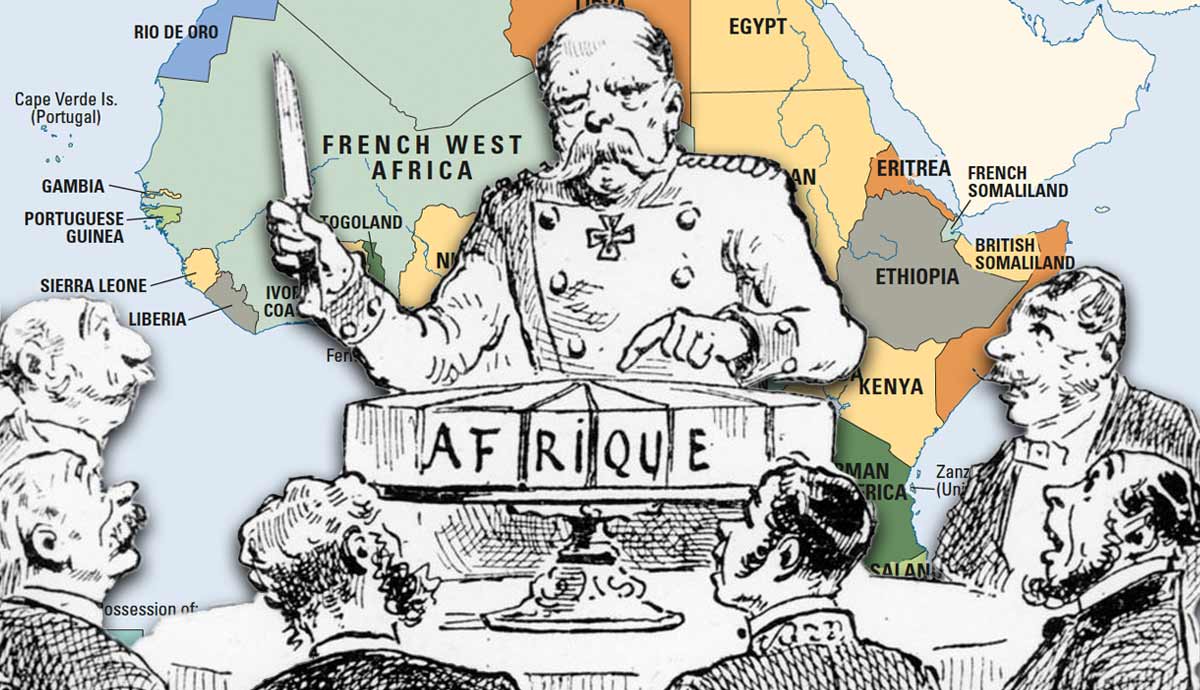
In the second half of the 19th century, European powers competed with each other in an effort to expand their control over the African continent. Known as the Scramble for Africa, this period of renewed colonial activity strained the relations between the Western countries. In November 1884, German Chancellor Otto von Bismarck organized the so-called Berlin Conference to prevent the highly-charged contest from degenerating into armed conflicts. During four-month-long negotiations, the European countries and the United States agreed to a series of rules to regulate the colonization of Africa. The resulting General Act led to the partition of the continent among the Western powers.
The Scramble for Africa & The Berlin Conference

In 1884, when German Chancellor Otto von Bismark gathered the representatives of thirteen European countries and the United States in Berlin, the so-called Scramble for Africa was already well underway. While the earlier European colonial efforts had focused on the Americas and Asia, in the second half of the 19th century, many European states began to look at the African continent with renewed interest. During the previous expansionist waves and the Atlantic Slave Trade, the Western powers had established a series of settlements and trading posts in the coastal areas of Africa. They rarely ventured into the hostile interior. Thus, in the 1870s, a large percentage of the continent was governed by indigenous chiefs and kings.
A decade later, in the 1880s, the Western countries, seeking to strengthen their international prestige and exploit the raw materials located in several African regions, began to exert their authority and control over the previously independent territories.
“In our time,” declared French Prime Minister Jules Ferry, “nations are great only through the activity they deploy; it is not by spreading the peaceable light of their institutions … that they are great, in the present day.”
Alongside the oldest colonialist powers, some new players, such as Belgium, Germany, and Italy, joined the mad rush to secure their hold over the most strategic areas. As a result, the Scramble for Africa led to suspicions and conflicts among the main rivals.

In North Africa, for example, Great Britain and France competed over the control of Egypt, especially after the opening of the Suez Canal had turned the country into a crucial spot in the routes to the East. In 1875, taking advantage of the Egyptian government’s financial difficulties, the British managed to acquire its shares, thus becoming the largest shareholder in the Suez Canal Company. Then, in 1882, when the Egyptians protested the foreign involvement in their internal affairs, Great Britain occupied the country. This turn of events alarmed the French, who hoped to restore their national pride after losing Alsace-Lorraine to Germany in the Franco-Prussian War.
As the tension among the Western powers also rose in other areas of the African continent, especially in the Congo Basin, where Belgium, France, Germany, Portugal, and Great Britain struggled for control, German Chancellor Otto von Bismarck called an international conference in Berlin to regulate the volatile expansionist endeavors. In particular, Bismarck feared that the disorderly race over the control of the African territories would upset the balance of power he sought to achieve in Europe.
Colonization in the 19th Century

In the 19th century, a combination of economic, social, and political factors led the European powers to embark on aggressive colonialist campaigns in Africa. During the 1873 Panic and the ensuing Long Depression, for example, many industrialized Western countries saw overseas expansion as a means to secure new open markets and outlets for their investment.
Most importantly, the African continent was rich in sought-after raw materials. Besides diamonds and gold, rubber, copper, and ivory (all unavailable in Europe) were especially in demand. Rubber, for example, was employed for the insulation of the newly introduced electrical and telegraph wires.
The technological advances of the Second Industrial Revolution also played a crucial role in enabling the 19th-century expansionist rush. While the invention of the telegraph made the communication of news and information easier and faster, railways and steamboats (running on the new triple-expansion engine) revolutionized the world of transportation, making vast portions of previously hard-to-reach areas accessible to merchants, missionaries, and explorers. As steamboats, telegraph lines, and trains became increasingly common features of the African landscape, another invention, the automatic machine gun, contributed to the fast colonization of the continent. In particular, the new type of firearm widened the technological gap in armaments between the Europeans and the African people, thus accelerating the rate of territorial conquest.

Before the 19th century, Africa was a largely unexplored area of the globe. The Western powers, busy with the Atlantic Slave Trade and the strengthening of the commercial routes with the East, had little interest in venturing into the hostile interior of the continent. The impenetrable forests separating the coastline from the hinterland, the unnavigable rivers, and the vast desertic regions discouraged traders and travelers from exploring most of Africa.
However, the new technology, alongside the improvement of quinine, a medicine now effective against malaria, led numerous Western geographers, naturalists, explorers, and missionaries to reach new regions. As a result, cartographers were gradually able to fill their previously blank maps of Africa with rivers and lakes.
European and American newspapers and journals regularly regaled their readers with stories of the most famous exploration missions, going as far as directly hiring reporters to travel to Africa. In 1871, the New York Herald sent journalist Henry Morton Stanley to Central Africa to locate David Livingstone, a Scottish missionary who had gone missing while searching for the source of the Nile.
In the second half of the 19th century, the explorers began to collaborate with the Western powers, signing treaties on their behalf with African chiefs. Often mistranslated, the treaties allowed the European countries to exploit the local resources and establish their control in the continent.
“Heart of Darkness”: The Struggle Over the Congo Basin

Stanley’s mission caught the attention of King Leopold II of Belgium, who had embarked on an ambitious expansionist policy. In particular, Leopold II aimed to establish his authority over the Congo Basin, seeking to exploit its resources to increase his wealth. To this end, in the 1870s, he founded the International Association of the Congo with the financial backing of a group of bankers. Then, at the beginning of the 1880s, the king sent Stanley on an expedition to the central African region.
From 1879 to 1882, the American reporter explored the areas surrounding the Congo River, negotiating treaties with the local chiefs and studying how to open up the basin to trade and colonization. Thus, in 1884, shortly before the Berlin Conference, Leopold II stated his claim over the entire Congo Basin, hoping to turn the territory into his personal colony.
As Stanley’s expedition unveiled the previously impenetrable African region to the Europeans, other Western countries became interested in the Congo Basin, turning it into perhaps the most sought-after overseas territory. France, for example, dispatched the Italian-born explorer Pierre de Brazza to Central Africa, where he founded the city of Brazzaville. As a result, Great Britain, attempting to thwart its colonial rivals’ expansionist designs on the area, opted to support Portugal’s claims on the Congo River. However, the bilateral negotiations between the two countries failed to reach an agreement.
Toward the end of 1884, in the face of the mounting tension, the Western powers finally agreed to meet in Berlin to introduce some rules in their frenetic Scramble for Africa.
The Berlin Conference

In Berlin, the participants of the conference focused on three main tasks: ensuring freedom of trade in the Congo Basin, establishing freedom of navigation on the Niger and Congo Rivers, and regulating the future colonization of African territories.
At the same time, the Berlin Conference recognized King Leopold II’s authority over the Congo region, where he formed the Congo Free State. On February 26, 1885, after four months of negotiations, the representatives of all nations signed the General Act of the Berlin Conference, thus agreeing to abide by the newly established rules in their future expansionist campaigns.
To avoid the outbreak of armed conflicts, Article 35 of the General Act stated that “any Power which henceforth takes possession of a tract of land on the coasts of the African continent outside of its present possessions … shall accompany the respective act with a notification thereof, addressed to the other Signatory Powers of the present Act, in order to enable them, if need be, to make good any claims of their own.”

The following Article 36 introduced a further requirement to rein in the chaotic colonial rush. Commonly known as “effective occupation,” the new norm committed the “signatory powers” to “insure the establishment of authority in the regions occupied by them on the coasts of the African continent sufficient to protect existing rights, and, as the case may be, freedom of trade and of transit.”
As they normalized the ongoing partition of Africa, the Western powers depicted their imperialist policy as a civilizing mission consisting of “instructing the natives and bringing home to them the blessings of civilization.”
In 1899, British writer Rudyard Kipling famously referred to this mission as “the white’s man burden.” In 1885, while the participants of the Berlin Conference committed themselves to “watch over the preservation of the native tribes, and to care for the improvement of the conditions of their moral and material well-being,” they neglected to invite the African leaders to take part at the meeting which would define the future of their countries.
New Imperialism & The Aftermath of the Berlin Conference

Far from slowing down the Scramble of Africa, the Berlin Conference accelerated the Western powers’ rush to expand their spheres of influence. At the outbreak of World War I, around 90 percent of Africa had been colonized. Only Liberia and Ethiopia remained independent. In 1896, Ethiopia’s emperor had successfully thwarted Italy’s expansionist endeavor during the First Italo-Ethiopian War. The partition of the continent among European countries had disastrous effects on the indigenous African peoples. In the Congo Free State, for example, the local population was decimated and slaughtered under King Leopold II’s harsh rule.
In the years following the Berlin Conference, the rules established in the General Act were only partially followed. Indeed, the notification requirement and the principle of “effective occupation” were ultimately unsuccessful in ending the rivalry between the colonialist powers, which continued to pursue their expansionist endeavors.
Contrary to their alleged pledge to preserve and protect the “native tribes,” the European countries proceeded to carve out their spheres of influence without any consideration for the already existing ethnic, linguistic, and cultural groups. The political and social effects of the artificial boundaries established during the Scramble for Africa still endure today.

Regardless of the effectiveness of the normative framework established by the Berlin Conference, the meeting legally and ideologically legitimized the Scramble for Africa. Thus, the event is commonly held as the embodiment of 19th-century New Imperialism, a period of territorial expansion justified by the erroneous belief in the superiority of the white race.
“It is our duty to seize every opportunity of acquiring more territory and we should keep this one idea steadily before our eyes that more territory simply means more of the Anglo-Saxon race, more of the best, the most human, most honorable race the world possesses,” claimed Cecil Rhodes in 1877.
Similarly, Jules Ferry, addressing France’s colonial policy, declared: “We must say openly that indeed the higher races have a right over the lower races … I repeat, that the superior races have a right because they have a duty. They have the duty to civilize the inferior races.”










